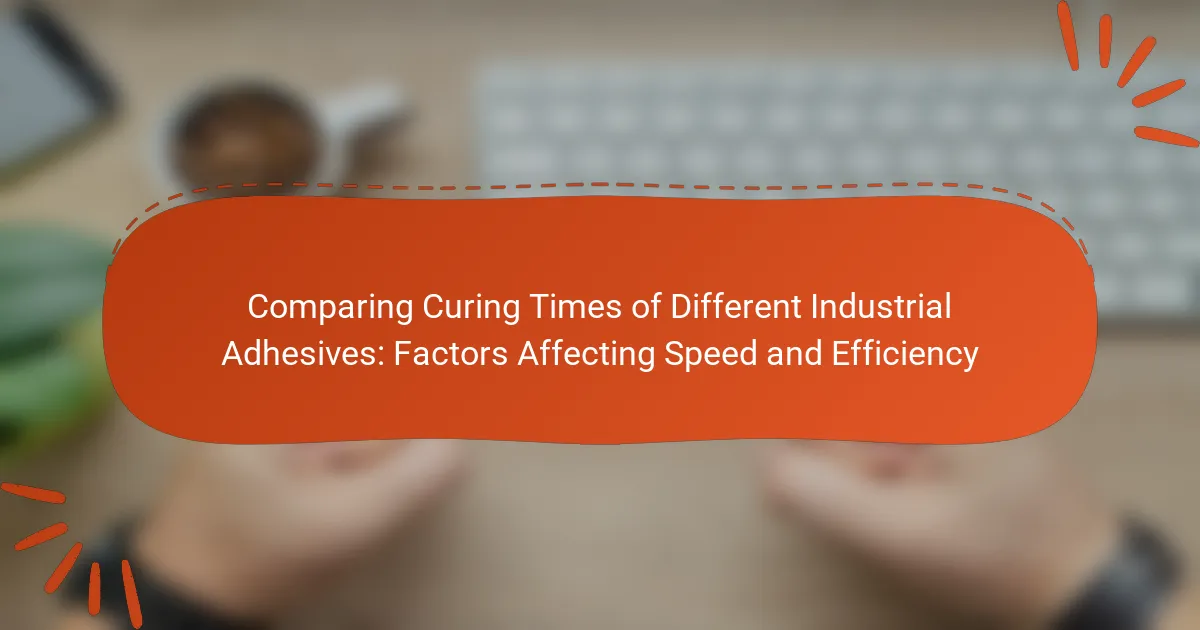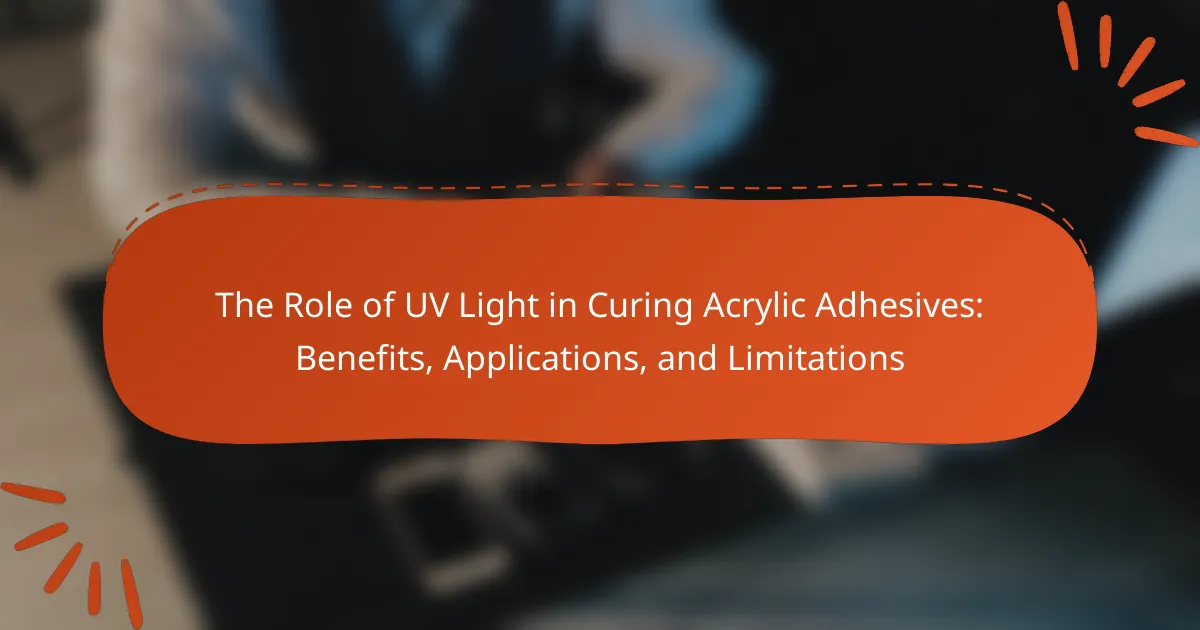Curing techniques for silicone adhesives are essential processes that enhance the performance and durability of these materials. The article outlines three primary curing methods: heat curing, which uses elevated temperatures to accelerate bonding; moisture curing, which relies on ambient moisture for room-temperature vulcanizing (RTV) silicones; and chemical catalyst curing, which involves additives that significantly reduce curing time and improve adhesive properties. Each technique presents unique advantages tailored to specific application requirements, making it crucial for users to understand their options for optimal results.
![]()
What are Curing Techniques for Silicone Adhesives?
Curing techniques for silicone adhesives include heat curing, moisture curing, and chemical catalyst curing. Heat curing involves applying elevated temperatures to accelerate the curing process. This technique is effective for achieving strong bonds quickly. Moisture curing relies on the presence of moisture in the air to initiate the curing reaction. This method is commonly used for room-temperature vulcanizing (RTV) silicones. Chemical catalyst curing utilizes specific additives to speed up the curing process. Catalysts can significantly reduce curing time and improve adhesive performance. Each technique offers distinct advantages depending on the application requirements.
How do curing techniques impact the performance of silicone adhesives?
Curing techniques significantly impact the performance of silicone adhesives. Different curing methods, such as heat, moisture, and chemical catalysts, affect the adhesive’s bond strength, flexibility, and durability. Heat curing enhances cross-linking, resulting in stronger bonds. Moisture curing allows for room-temperature application, which can be advantageous for various environments. Chemical catalysts can accelerate curing times, improving productivity. Research indicates that optimal curing conditions lead to adhesives with superior resistance to temperature fluctuations and environmental factors. Thus, the choice of curing technique is crucial for achieving desired performance characteristics in silicone adhesives.
What are the key factors that influence the curing process?
The key factors that influence the curing process of silicone adhesives are heat, moisture, and chemical catalysts. Heat accelerates the curing reaction by increasing the mobility of molecules. Higher temperatures typically lead to faster curing times. Moisture acts as a catalyst in moisture-curing silicone adhesives. It initiates the crosslinking process essential for curing. Chemical catalysts enhance the curing speed and efficiency. They lower the activation energy required for the curing reaction. Each factor plays a critical role in determining the final properties of the cured adhesive. The combination of these factors must be optimized for effective curing.
How does the curing process affect adhesion strength?
The curing process significantly enhances adhesion strength in silicone adhesives. During curing, chemical reactions occur that promote cross-linking between polymer chains. This cross-linking increases the material’s structural integrity and bond formation with substrates. Increased temperature during curing can accelerate these reactions, leading to stronger adhesion. Additionally, moisture can also influence the curing process, allowing for better bonding in humid environments. Studies show that properly cured silicone adhesives can achieve adhesion strengths exceeding 200 psi on various surfaces. Thus, the curing process is crucial for maximizing adhesion strength in silicone adhesives.
What are the different types of curing techniques for silicone adhesives?
The different types of curing techniques for silicone adhesives include heat curing, moisture curing, and chemical curing. Heat curing involves applying elevated temperatures to accelerate the curing process. This method is often used in industrial applications for faster bonding. Moisture curing relies on ambient humidity to initiate the curing reaction. It is commonly used in sealants and adhesives exposed to moisture. Chemical curing utilizes specific catalysts to promote curing at room temperature. This technique provides flexibility in application and is suitable for various substrates. Each method has distinct advantages based on the application requirements.
What is heat curing and how does it work?
Heat curing is a process that uses elevated temperatures to accelerate the curing of silicone adhesives. During heat curing, the adhesive undergoes a chemical reaction that transforms it from a liquid to a solid state. This reaction typically involves cross-linking of polymer chains, which enhances the adhesive’s strength and durability. The process usually requires specific temperature ranges, often between 150°C to 200°C, depending on the adhesive formulation. Heat curing can significantly reduce the time needed for the adhesive to achieve its full bonding strength. This technique is commonly used in industrial applications where fast processing times are essential. Studies show that heat curing can improve the performance characteristics of silicone adhesives, such as thermal stability and adhesion strength.
What role does moisture play in the curing of silicone adhesives?
Moisture acts as a critical component in the curing process of silicone adhesives. Silicone adhesives cure through a reaction with moisture in the air. This moisture allows the silicone to polymerize, forming a solid bond. The presence of moisture facilitates the cross-linking of silicone chains. This cross-linking enhances the adhesive’s strength and durability. A higher humidity level can accelerate the curing time. Conversely, low moisture environments may prolong the curing process. Therefore, moisture is essential for achieving optimal performance in silicone adhesives.
How do chemical catalysts facilitate the curing process?
Chemical catalysts accelerate the curing process of silicone adhesives. They lower the activation energy required for the reaction between the adhesive components. This results in a faster formation of cross-links, which solidifies the adhesive. Catalysts also promote specific chemical reactions without being consumed in the process. For example, platinum-based catalysts are commonly used for silicone systems. They can significantly reduce curing time from hours to minutes. Studies show that the presence of catalysts can enhance the final properties of the cured adhesive. This includes improved tensile strength and thermal stability.
What are the advantages and disadvantages of each curing technique?
Heat curing offers rapid curing times and strong adhesion. However, it requires precise temperature control to avoid damaging the adhesive. Moisture curing is beneficial for its ability to cure at room temperature and in humid environments. Its downside is slower curing rates compared to heat curing. Chemical catalyst curing allows for flexible working times and can enhance bond strength. The disadvantage is the potential for inconsistent results if not mixed properly. Each technique has unique benefits and limitations that influence its application in silicone adhesive bonding.
What are the benefits of heat curing silicone adhesives?
Heat curing silicone adhesives offer several benefits. They provide rapid curing times, allowing for quicker production cycles. This method enhances adhesion strength compared to other curing techniques. Heat curing also improves the thermal stability of the adhesive. It results in better resistance to environmental factors such as moisture and temperature fluctuations. Additionally, heat curing can reduce the risk of contamination during the curing process. This technique is particularly effective for applications requiring high-performance bonds. According to industry studies, heat-cured silicone adhesives can withstand extreme conditions, making them ideal for demanding applications.
What challenges are associated with moisture curing?
Moisture curing presents several challenges. One challenge is the dependency on environmental humidity levels. Low humidity can hinder the curing process. High humidity, on the other hand, can lead to improper adhesion. Another challenge is the potential for uneven curing. This can result in inconsistent material properties. Additionally, moisture-sensitive substrates can be damaged during the curing process. Temperature fluctuations can also affect the curing rate. Finally, moisture contamination can compromise the final product’s integrity.
How do chemical catalysts enhance or complicate the curing process?
Chemical catalysts enhance the curing process by accelerating the rate of chemical reactions. They lower the activation energy required for curing, allowing the silicone adhesive to set more quickly. This results in faster production times and improved efficiency in manufacturing.
However, chemical catalysts can also complicate the curing process. They may introduce variability in the curing time and final properties of the adhesive. Different catalysts can react differently under varying conditions, leading to inconsistent results.
For example, the presence of moisture can affect the performance of certain catalysts. This can lead to incomplete curing or undesirable physical properties. Understanding the specific catalyst used is crucial for optimizing the curing process.
How can one choose the right curing technique for specific applications?
Choosing the right curing technique for specific applications involves evaluating the requirements of the silicone adhesive. Factors to consider include the environmental conditions, desired cure speed, and the type of substrate. Heat curing is effective for applications requiring rapid curing and high strength. Moisture curing is suitable for environments with high humidity and allows for flexibility in application. Chemical catalysts can enhance curing in low-temperature conditions, making them ideal for specific industrial settings. Each technique has unique attributes that align with different application needs, ensuring optimal performance of the silicone adhesive.
What factors should be considered when selecting a curing method?
When selecting a curing method for silicone adhesives, consider temperature, humidity, and catalyst type. Temperature affects the curing speed and final properties of the adhesive. High temperatures can accelerate curing but may also lead to degradation. Humidity levels influence moisture-cured silicone adhesives, impacting their performance. The type of catalyst determines the curing mechanism and reaction time. Additionally, the application environment and substrate compatibility are crucial for successful adhesion. Each factor plays a significant role in achieving optimal results with silicone adhesives.
How do environmental conditions affect the choice of curing technique?
Environmental conditions significantly influence the choice of curing technique for silicone adhesives. Temperature affects the rate of curing; higher temperatures generally accelerate the curing process. Humidity levels also play a crucial role; certain silicone adhesives require moisture to cure effectively. In dry conditions, alternative curing methods may be preferred. Additionally, chemical catalysts can be sensitive to environmental factors, impacting their effectiveness. For example, some catalysts may require specific temperature ranges to function optimally. Therefore, understanding the environmental context is essential for selecting the appropriate curing technique.
What are common troubleshooting tips for curing silicone adhesives?
Ensure proper mixing of silicone components. Inadequate mixing can lead to incomplete curing. Maintain a clean surface for application. Contaminants can prevent proper adhesion and curing. Control the temperature and humidity during curing. Ideal conditions typically range from 65°F to 80°F and 40% to 60% humidity. Allow sufficient curing time based on the manufacturer’s guidelines. Curing times can vary significantly between products. Check for compatibility with substrates. Some materials may inhibit curing if not compatible. Use appropriate catalysts if required. Certain silicone adhesives need added catalysts for optimal curing.
How can one identify and fix curing issues in silicone adhesives?
To identify and fix curing issues in silicone adhesives, check for surface tackiness or incomplete bonding. Surface tackiness indicates insufficient curing, often due to inadequate moisture or heat. Inspect the adhesive application environment for humidity levels and temperature. Ideal curing conditions typically require a temperature range of 20-30°C and humidity above 50%.
If curing issues are present, increase the ambient temperature or humidity. Applying additional heat can accelerate the curing process. In cases of prolonged curing times, consider using a catalyst to enhance the reaction.
For example, adding a moisture-curing silicone can improve adhesion in low-humidity environments. Additionally, ensure proper mixing of components, as incorrect ratios can hinder curing.
Regularly reviewing the manufacturer’s guidelines can also help in troubleshooting and ensuring optimal performance of silicone adhesives.
What are best practices for achieving optimal curing results?
To achieve optimal curing results for silicone adhesives, maintain consistent temperature and humidity levels. Ideal curing temperature typically ranges from 20°C to 30°C. Humidity should be kept above 50% for moisture-cure silicones. Use appropriate catalysts to enhance curing speed and effectiveness. Ensure surfaces are clean and free from contaminants before application. Apply the adhesive in a uniform layer to promote even curing. Allow sufficient time for curing, generally 24 hours for full strength. These practices enhance bond strength and durability.
Curing techniques for silicone adhesives, including heat curing, moisture curing, and chemical catalyst curing, are essential for achieving optimal adhesive performance. Each method impacts bond strength, flexibility, and durability, with heat curing providing rapid bonding, moisture curing allowing for room-temperature applications, and chemical catalysts enhancing curing speed. Key factors influencing the curing process include temperature, humidity, and the type of catalyst used, all of which affect the final properties of the adhesive. Understanding these techniques and their implications is crucial for selecting the appropriate method based on specific application requirements.


